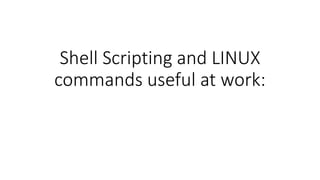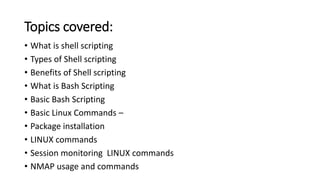Shell scripting and Linux commands that are useful for work are covered in the document. Some key points include:
- A shell script is a list of commands that can be executed by the shell to perform operations like running programs, manipulating files, and printing text. Common shell scripts include Bash, CSH, and KSH.
- Benefits of shell scripts include reusability, readability, and the ability to leverage powerful UNIX tools like awk, grep, and sed.
- The document outlines several basic Linux commands for file/directory navigation, permissions, and more. It also covers useful network administration commands and environment variables.







![Setting Of PS1 variable: export PS1="e[0;32m[u@h W]$ e[0m"
• e[ – Begin color changes
• 0;32m – Specify the color code
• [u@h W]$ – This is the code for your normal BASH prompt (username@hostname Workingdirectory $)
• e[0m – Exit color-change mode
The first number in the color code specifies the typeface:
• 0 – Normal
• 1 – Bold (bright)
• 2 – Dim
• 4 – Underlined
The second number indicates the color you want:
• 30 – Black
• 31 – Red
• 32 – Green
• 33 – Brown
• 34 – Blue
• 35 – Purple
• 36 – Cyan
• 37 – Light gray
Additionally, if you combine the bright option with a color code, you get a lighter version of that color. For example, if you use color code 1;32, you would get light green instead of the normal green. If you use 1;33, you get yellow instead of brown.
The second number indicates the color you want:
• 30 – Black
• 31 – Red
• 32 – Green
• 33 – Brown
• 34 – Blue
• 35 – Purple
• 36 – Cyan
• 37 – Light gray
Additionally, if you combine the bright option with a color code, you get a lighter version of that color. For example, if
you use color code 1;32, you would get light green instead of the normal green. If you use 1;33, you get yellow instead
of brown.](https://image.slidesharecdn.com/linuxadmincommands-220914190754-4998629c/85/LINUX_admin_commands-pptx-8-320.jpg)





![Basic Bash Scripting:
• Conditional execution:
git commit && git push
git commit || echo
• Conditions:
if [[-z “$string”]];
then
echo “String is empty”
elif [[-n “$string”]]; then
Echo “String is not empty”
fi
• Brace expansion:
• echo {A,B}.js
• {A,B} – Same as A B
• {A, B}.js – Same as A.js B.js
• {1…5}- Same as 1 2 345
• Strict mode:
• Set –euo pipefail
• IFS=$’nt’](https://image.slidesharecdn.com/linuxadmincommands-220914190754-4998629c/85/LINUX_admin_commands-pptx-14-320.jpg)
![Useful commands with LINUX machine:
1. ss: used to dump socket statistics.
• [root@ins-qasvr-common05 Automation]# ss -a | grep ssh
• LISTEN 0 128 :::ssh :::*
• LISTEN 0 128 *:ssh *:*
• ESTAB 0 0 172.31.201.214:37118 172.31.146.95:ssh
• ESTAB 0 0 172.31.201.214:51378 172.31.144.92:ssh
• [root@ins-qasvr-common05 Automation]#
We have active SSH connections from 172.31.146.95](https://image.slidesharecdn.com/linuxadmincommands-220914190754-4998629c/85/LINUX_admin_commands-pptx-15-320.jpg)
![• 2) Last : Searches back through
the file /var/log/wtmp (or the
file designated by the -f flag) and
displays a list of all users logged
in (and out) since that file was
created.
• 3) W: Displays information
about the users currently on
the machine, and their
processes
[root@node3 ~]# last -a | grep -i still
deepak pts/1 Fri May 31 16:58 still logged in 10.0.2.31
root pts/2 Fri May 31 16:50 still logged in 10.0.2.30
root pts/0 Fri May 31 09:17 still logged in 10.0.2.2
[root@node3 ~]# w
17:01:41 up 7:44, 3 users, load average: 0.00, 0.01, 0.05
USER TTY FROM LOGIN@ IDLE JCPU PCPU WHAT
root pts/0 10.0.2.2 09:17 9:41 0.31s 0.00s less -s
deepak pts/1 10.0.2.31 16:58 3:06 0.03s 0.03s -bash
root pts/2 10.0.2.30 16:50 5.00s 0.07s 0.02s w](https://image.slidesharecdn.com/linuxadmincommands-220914190754-4998629c/85/LINUX_admin_commands-pptx-16-320.jpg)






